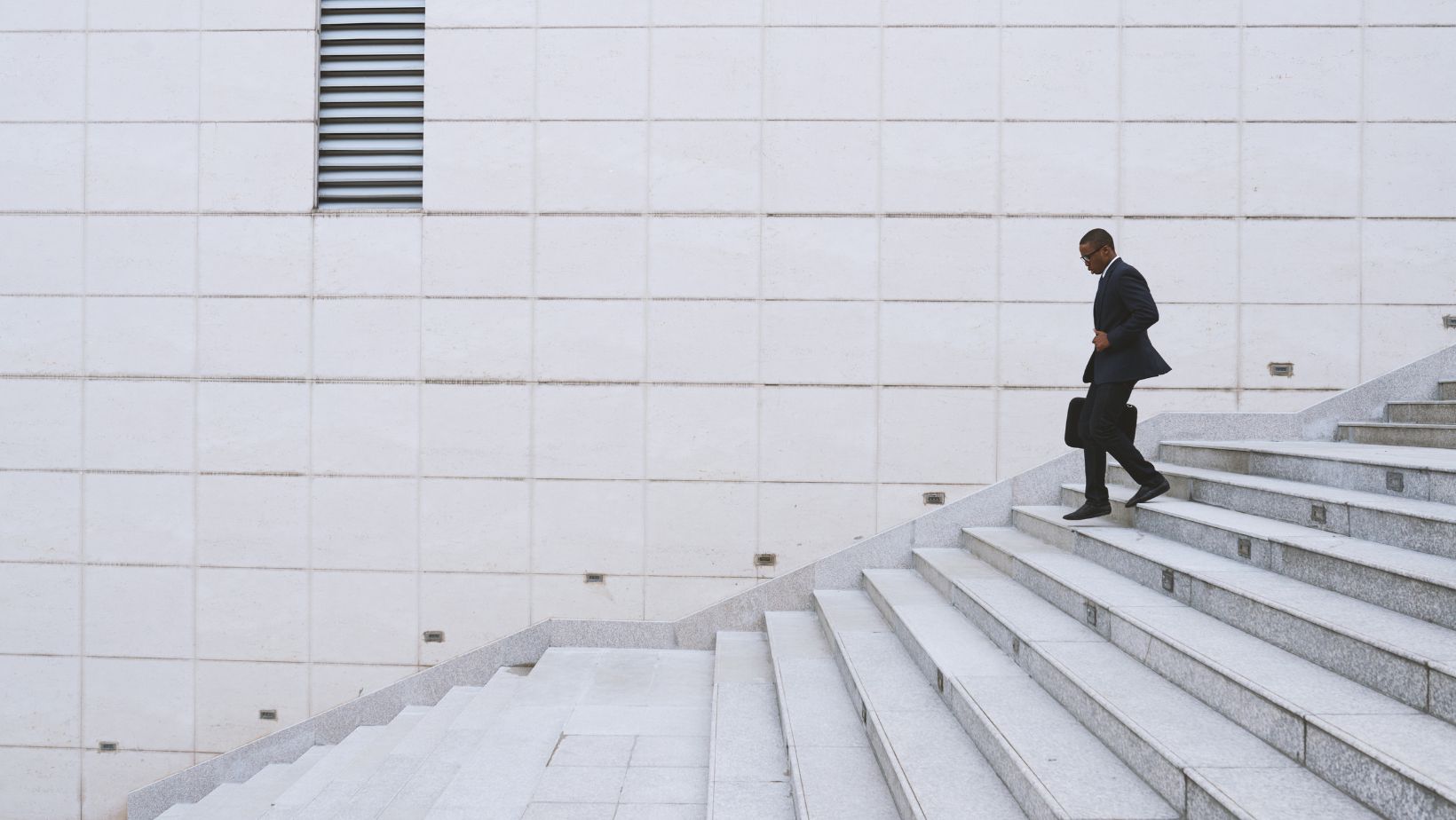
Have you ever taken a misstep on the stairs and felt your heart skip a beat? According to the National Floor Safety Institute, falls are a leading cause of injury, especially for older adults. Many of these falls happen on stairs and can result in serious injuries.
But before you resign yourself to taking the elevator forever, let’s explore the common causes of slip and fall accidents on stairs and what legal responsibilities property owners have in preventing them.
Common Causes of Stair-Related Accidents
Stair-related accidents can happen to anyone, regardless of age or physical abilities. However, certain factors can increase the risk of falling on stairs. Here are some of the most common causes:
Substandard Construction
Sometimes, the very design of the stairs themself sets the stage for a fall. This can include:
- Uneven treads or risers: Stairs with steps of inconsistent height can disrupt your walking rhythm and cause you to lose balance.
- Missing or loose handrails: Handrails offer crucial support, especially when descending stairs. Their absence or poor condition significantly increases the risk of a fall.
- Slippery or inadequate tread material: Certain materials, like polished marble or worn carpeting, can be slippery, especially when wet. To prevent falls, stairs should have a non-slip surface.
Poor Maintenance
Even well-constructed stairs can become dangerous if not properly maintained. Examples of neglect that can lead to stair-related accidents include:
- Worn or damaged treads: Cracked, chipped, or uneven treads create tripping hazards.
- Lack of proper lighting: Dim lighting makes seeing potential hazards on the stairs difficult.
- Accumulation of debris or clutter: Leaving objects on stairs creates obstructions and increases the risk of tripping.
- Faulty handrails: Loose or broken handrails become unreliable when needed.
Inadequate Signage and Warnings
Occasionally, the stairs may not be inherently dangerous but lack proper warning signs or markings. Missing or unclear warning signs, like those indicating steps with a different height or a change in direction, can catch people off guard.
The lack of wet floor signage can also be a significant risk factor in areas prone to spills, like near building entrances or kitchens.
Legal Responsibilities of Property Owners
Property owners have a legal responsibility to keep their premises safe for visitors. This includes ensuring the safety of stairways. Property owners can be legally liable for stair-related accidents in three key ways.
Duty of Care
Property owners are legally obligated to provide a reasonably safe environment for anyone who enters their property. This duty of care extends to all common areas, including stairwells, corridors, and entranceways. To fulfill this obligation, property owners must regularly inspect the premises to identify any potential hazards.
Once a risk is identified, prompt repairs or modifications must be undertaken to mitigate the hazard. Examples of fulfilling this duty include fixing loose handrails, replacing worn stair treads, and ensuring adequate lighting in stairwells. Failure to adhere to these responsibilities can lead to accidents, for which the property owner may be liable.
Building Codes and Regulations
Adhering to building codes and regulations is critical for stair construction and maintenance. These standards are established to ensure public safety by specifying minimum requirements for stair dimensions, materials, handrails, and lighting, among other features. Compliance with these codes helps prevent accidents and protects property owners from legal liability.
Non-compliance with building codes can lead to severe legal consequences for property owners. It can result in penalties, fines, and mandatory correctional actions, which could be costly.
More significantly, if a stair-related accident occurs due to code violations, the property owner may be liable for negligence. This stairwell liability can lead to lawsuits, increased insurance premiums, and, in severe cases, criminal charges if gross negligence is determined.
Foreseeable Hazards
Property owners must remain vigilant about hazards that, while not immediately obvious, can be anticipated and preemptively managed. An essential aspect of this responsibility involves identifying and addressing potential dangers before they lead to accidents.
A prime example is managing ice buildup during the winter months. Ice on stairs significantly increases the risk of slips and falls, posing a severe hazard to anyone traversing the stairway.
To mitigate this risk, property owners should regularly remove snow and ice, apply anti-slip treatments, and provide adequate warnings. Failing to address such foreseeable hazards can lead to injuries that are entirely preventable, putting property owners at risk of liability for negligence.
Common Injuries Caused by Stairway Falls
Falls on stairs can result in many injuries, from minor scrapes and bruises to more severe traumas. Some of the most common injuries caused by stairway falls include:

- Sprains and strains: When trying to catch yourself during a fall, you may twist or overextend your joints, resulting in sprains or strains.
- Broken bones: The impact of a fall can cause fractures in various parts of the body, including the wrists, ankles, and hips.
- Head injuries: Falls on stairs can also result in head injuries, ranging from mild concussions to severe traumatic brain injuries.
- Spinal cord injuries: In severe cases, a fall down stairs can result in spinal cord injuries that can lead to temporary or permanent paralysis.
- Cuts and bruises: Minor falls on stairs can still result in cuts, scrapes, and bruises that may require medical attention.
Legal Options for Stairway Fall Victims
If you have been injured in a stairway fall due to a property owner’s negligence, you may be entitled to compensation for your injuries. Here are three potential legal options that stairway fall victims may pursue:
Personal Injury Lawsuit
A personal injury lawsuit is a civil case where an individual seeks compensation from another party for injuries sustained due to their negligence. In the case of a stairway fall, this could include compensation for medical expenses, lost wages, and pain and suffering.
To win a personal injury lawsuit, the victim must prove that the property owner had a legal duty to maintain safe stairs, failed in that duty, and that their negligence directly caused the injuries sustained.
Workers’ Compensation Claim
You may be eligible for workers’ compensation benefits if you were injured while on the job. This type of insurance provides medical and financial support to injured employees.
To receive workers’ compensation benefits for a stairway fall, you must prove that your injuries were work-related. This may include falls while performing work duties or traveling between different work locations.
Premises Liability Claim
Premises liability refers to the legal responsibility of property owners to maintain safe conditions for visitors. In the case of a stairway fall, this could include injuries sustained by customers, guests, or tenants.
To successfully pursue a premises liability claim, you must prove that the property owner knew or should have known about the hazardous condition and failed to take appropriate action to fix it. Additionally, you must show that the hazardous condition was the direct cause of your injuries.
Get Legal Help for Your Stairway Fall Case
If you have been injured in a stairway fall, it is crucial to seek legal assistance to ensure your rights are protected and receive the compensation you deserve. A qualified personal injury lawyer can help determine the most appropriate legal option for your case and guide you through the legal process.


